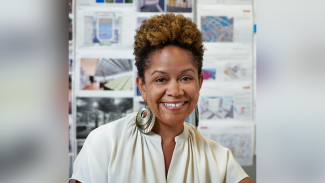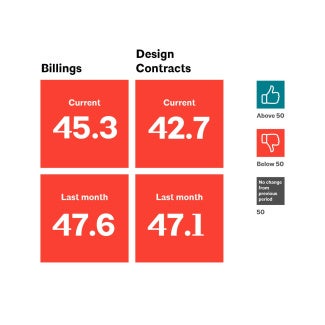Marnique Heath, FAIA, on why prioritizing diversity leads to unique ways of thinking about design
In honor of Black History Month we spoke with Marnique Heath, FAIA, on diversity in the architecture world, challenges facing the profession, and why architects should be civil servants.

Marnique Heath, FAIA, is a Principal and Chair of the Board of Directors of STUDIOS Architecture based in Washington D.C. She was recognized as a member of AIA's College of Fellows in 2023.
Raised in Virginia Beach, Heath received both her Bachelors and Masters degrees in architecture from the University of Virginia and started at STUDIOS soon after. Still at the firm 25 years later, Heath leads their Diversity, Equity, Inclusion, and Belonging (DEIB) Council which advances issues related to DEIB both internally and externally.
In honor of Black History Month, we spoke with Heath about people that inspire her, diversity in the architecture field, and much more.
What inspired you to become an architect?
When I was really young I loved to do things that involved making or drawing. When I had time on my own I’d make things out of random scraps I’d find around the house, or draw what I saw from magazines. A lot of that was fashion and interior design oriented, but it was all in the spirit of being creative.
As I got a little older, my parents started talking to me about different things I could explore in creative fields and architecture was one of those things. They presented it to me as something that would allow me to explore a lot of different avenues with design, and that’s proven to be true. We touch a lot of different things like the scale of cities, the scale to parks, to buildings, to the scale of interiors and furniture and products. I’ve always maintained an interest in all of those scales.
By the time I was in high school, my parents started to connect me to people they knew who led architecture firms locally. I had a chance to see what architects did and learn about the profession that way. When it was time to go to college, I knew architecture was the path I wanted to take.
Who are your biggest role models?
Shortly after starting Architecture School at the University of Virginia Bill McDonough became our dean and an early mentor. He was somebody I worked closely with in a leadership capacity through the school and got to know very well. At the time, he was establishing a brand as a national voice on sustainability, and I don’t think we realized just how prominent his voice was becoming and how important his work was. He inspired me to begin thinking about how we design and how we can design in ways that help protect the earth.
Kenneth Schwartz, who was one of my first professors at UVA and went on to become the dean of the school of architecture at Tulane, has been a role model and mentor to me for many years. He’s remained in touch with me over the years and would bring opportunities to me like participating in NCARB or speaking at conferences. He was the one who encouraged me to apply for AIA fellowship and he was my sponsor.
There are people who weren’t direct mentors but inspired me, like seeing Diane Hoskins in her role as a leader at Gensler. As a young black woman seeing another black woman in that leadership position was inspiring and showed me what was possible. I hope to be that for someone else.
You’re chair of the District of Columbia Historic Preservation Review Board. Can you describe some of the key work that board has accomplished while you’ve been involved and why is it important for architects to be civil servants?
I really enjoy that the work we do as a board is design-oriented. It’s about influencing the built environment in a way that helps preserve our history. Architects are taught early in our academic life to be problem solvers in a unique way. We are challenged to consider what the applicant is trying to accomplish, what regulations say, and what the community wants. Oftentimes there are different perspectives so there’s a lot of problem solving there.
One of the biggest things the board has accomplished during my tenure is focusing on telling the full history of the places that we help preserve. This means capturing the within nominations whether or not black people or people of color were excluded from occupying these places. We’ve also focused on those nominations that tell the stories of underrepresented groups.
You founded the Diversity, Equity, Inclusion, and Belonging Council at STUDIOS. What does that council work towards and why is diversity especially important in the world of architecture?
Architecture, for so many years, has been a white man’s profession. I’m excited to be part of a firm that recognizes that phenomenon needs to change and that by bringing more voices to the table the solutions we propose are much more rich.
While it wasn’t always overtly spoken, I could see in the way that we’ve operated that we’ve always believed in giving people the opportunity to have a voice through design. One of the reasons I’ve remained at STUDIOS my entire career is because I had freedom to lead early. I think young women, African Americans, Latinos, Asians, any underrepresented populations can bring a different perspective to the table. It’s important to have diversity to represent the diverse communities we touch and it’s important to let that diversity influence us to think about design in new and different ways.
Diverse voices also means people who are new to the profession. People who bring new ideas and new energy. As architects we must be more open and receptive to more voices in these discussions.
STUDIOS DEIB Council ensures we bring diverse voices into the firm. We ensure equitable hiring practices and that we’re looking beyond the traditional schools that we may have relied on in the past for potential candidates. The Council also hosts events where the stories and experiences of underrepresented groups are celebrated to expose everyone in the studio to experiences beyond their own.
What are some of the biggest challenges facing the future of architecture? What are your thoughts on the state of the profession in 2024 and beyond?
Post-pandemic we’re still trying to figure out what the new normal is for how we work. Many of us who have been in the profession a long time see the value of people coming together to collaborate versus being at home and working on your own. The challenge of hybrid work in a creative, collaborative field is something we need to solve for, it’s really hard for people who are new to the profession to learn as much as they need to as quickly as we’d like them to when they’re not here and they’re not being seen.
I talk to a lot of our newer staff and our minority staff in particular about this and the importance of being seen. It’s very important for your future and to elevation. If you disappear you can be forgotten pretty easily.
Another big challenge we’re trying to figure out is how to not be replaced by artificial intelligence. How can we use it effectively as a tool when necessary without being replaced by it.
For those of us who work in and on cities, we need to figure out how our cities will evolve. Architects have a major role to play in this reinvention. It impacts the work we do and our ability to maintain our businesses. We see vacancy rates within office buildings ever increasing and the landscape of architecture becoming much more competitive. We must continue to keep younger architects and designers engaged and to reward them financially while dealing with these challenges, particularly in our urban markets.



